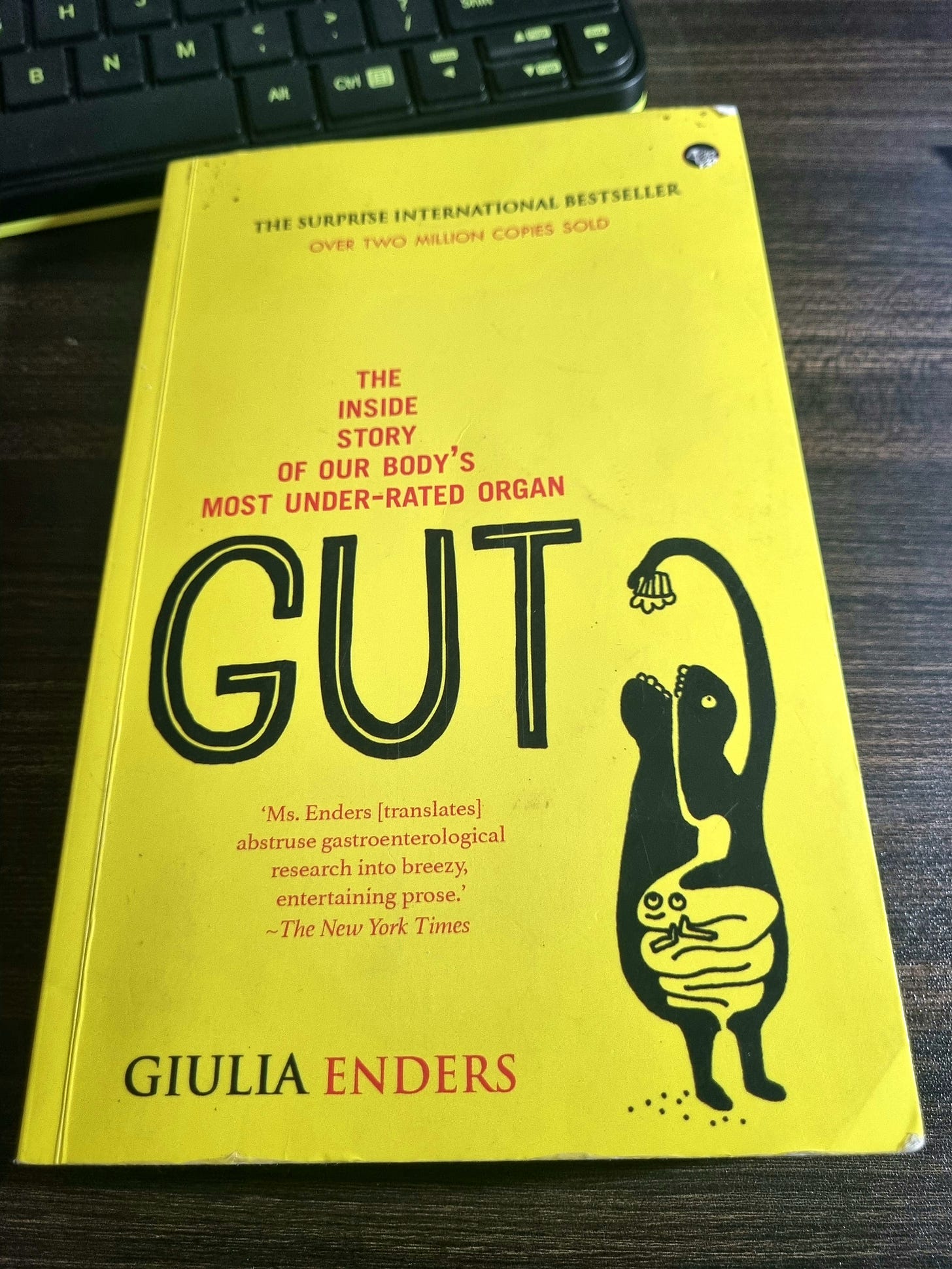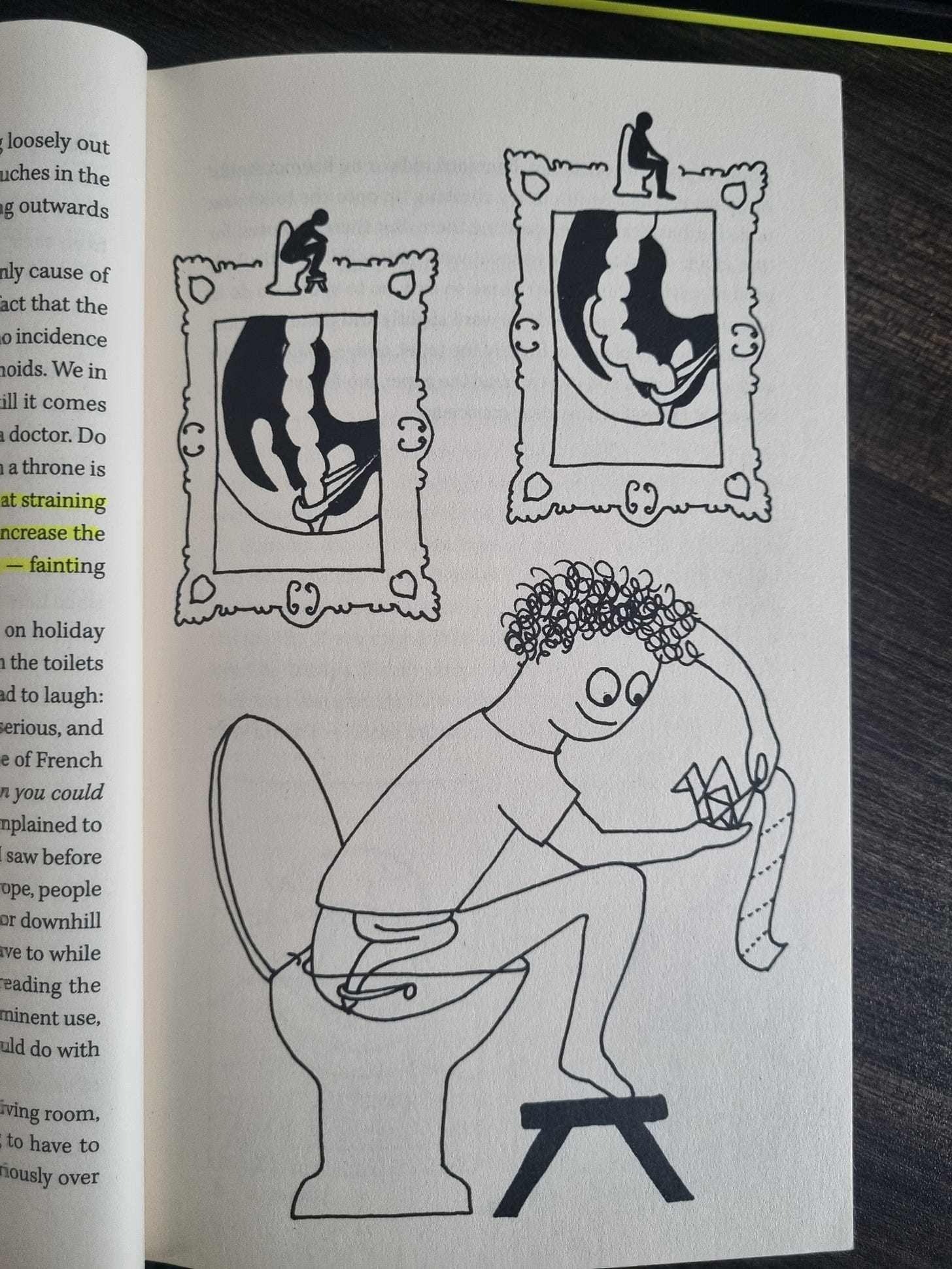GUT Is More Than You Think
GUT by Giulia Enders is a fun & an easy to digest (it’s gut after all) book for a better you literally, not just psychologically.
Many of us often have gut feelings. Some use them as compass while others ignore them. This compass might or might not work for many. Nonetheless, our gut does impact us. Some let it pass while some pass along. The choices we make based on what our bodies signal may or may not be solid, but their presence should pique our awareness about what’s brewing inside. After all, our body is our biggest friend and it provides clues to how it’s feeling.
I’ve decided that this year I’m solely going to focus on human nature. One of the best pieces of advice I read last year was to choose one topic and dedicate at least a year to it so one can be amazed about what could be achieved in a year. I started off with health and wellness because it’s an incomplete attempt to understand human nature if one solely focuses on mind while excluding how our physiology also shapes it. Hence, my initial three articles about the Lifespan book, apology and human dharma (dos and don'ts).
While sifting through the racks of Bahrisons bookstore looking for a random title about mind-gut connection, I got my hands on Guilia Enders’s book GUT. She is a 2-time winner of the Hearaeus foundation and studies microbiology. In 2012, her presentation of Gut won her first prize at the Science Slam in Berlin, which went viral on YouTube. The author’s introduction, the book design and subject, and a short length of 250 pages were sufficient reasons to put it in the cart.
Did you know that our gut produces more than 20 unique hormones and it accounts for two-thirds of our immune system?
I didn’t either. Much to learn from this fun to read science book.
Author’s Intent
In the foreword of the book, Giulia flashlights her initial years which carried physiological issues like inability to be breastfed, gastrointestinal issues, lactose intolerant and developing ‘sores’ over the body. She did not find refuge in the medicine of the time. Alas, she chose to do her own research. While doctors were giving her vague diagnosis like nervous eczema, she found out that it was a gut issue. It helped her in suitable diagnosis and eventual cure from her ailments. And, she chose the field of medical microbiology to walk down the less trodden and opaque terrain of gut science.
Her intent is to inform the public about important scientific research easily, which in her view usually stays behind closed doors during scientific discussions. Laying complex science for a layman is visible in her book with engaging writing style and less jargon. The hallmark of a good thinker and an explainer is to simplify complexity and paint it visually easy for the reader. Giulia has done it quite well.
The book is themed into 03 parts- Gut Feeling, The Nervous System of the Gut, and The World of Microbes- and so will my note series be. I’ll publish a 03-part series based on the book.
Let’s begin.
The Gut Feeling
“If we could see more than meets the eye, we could watch as a clump of cells grows into a human being in a woman's tummy.”-Giulia Enders
In my mind, I’m like,
“Cells did salsa, and they go crazy in dance,
Yet there is symmetry and structure,
I ask, did we happen by chance?
Or is there a chance that it’s not some random cellular romance?
They come together, in million and billion,
And forms life, every one of which is special like one in a zillion.
That’s our chance,
Life is dance, after all, so be in a romance.
Be it a person, passion, or obsession, live like that’s your only chance.”
Giulia simplifies the internal human body into three tubes, with protrusions and knots. Categories are good, aren’t they? I can never forget the analogy now. The first tube is the cardiovascular, the second is the nervous, and the third one is the intestinal. The book focuses on the third tube – the gut. The first two tubes are held in high regard, while the third is often ignored.
How does pooing work? And why that’s important.
What we do in the loo is masterful. Two nervous systems dispose of our waste discreetly and hygienically, thanks to the craftsmanship of our Sphincters. Most people might know the outer but few know the inner one just a centimetre away. If communication between them is hindered, we are constipated.
The jobs of sphincters
Inner sphincter- (autonomous)
Keep all unpleasantness at bay.
Keep everything comfortable and in its place.
When left over food reaches its gate, it allows a small ‘taster through to the space between both sphincters.
This centimetre space is filled with sensor cells which analyse whether the product is gaseous or solid and rings up the brain.
That’s when you feel the urge to do nature’s call.
Outer sphincter- (under our control)
Deals with our external complications and becomes part of complex decision making.
Since it is manual, the burden is on us to choose whether to let that air out or hold.
It after all works in tandem with our social surroundings and embarrassments.
If we choose not to, the taster goes back to the inner sphincter.
Inner guy’s job is not to keep it there. After a while, it again attempts to send it through and you get another loo call which if you miss makes the next call more severe.
Let me present this science with an easier analogy-
Inner sphincter is a caller (autonomous) over the phone and outer sphincter is you receiving the call. The caller has got something important to say and you miss it. (Assume that only relevant things are communicated over the calls. As nature, unlike us, doesn't do anything without a sense.) After a while, the caller attempts more and you finally answer the call when enough pressure is built. But, oh boy, that stress after missing so many calls is something we can relate to. Don’t turn those calls into missed calls just like we do on phones.
Are you sitting properly?
Answer is no, if you use western seats. Research by Japanese and Israeli scientists have confirmed that squat position pooping is the most effective design there is. So, our age-old Indian seating style, also followed in various parts of the world, is after all great.
If you don’t have an Indian toilet seat, worry not. All you need is a footrest to raise the knees and angle your back forward. This gives the perfect angles for the body-waste to go out in a haste.
If you sit like you do on a chair or stand, there is a natural knot to the gut which obstructs the path of the poop. Nature has designed it in such a way to avoid embarrassment. If we sit in a squat position, then the kink is gone (imagine a hose pipe which if you press obstructs the flow) and the flow flows out with a show.
The Gateway to Gut
It starts with eating right. Our mouths have four salivary points which aids in digestion.
Two Parotid Papillae- Found on either side, opposite to molars, and their job is to secrete saliva when needed.
Two Sublingual Papillae- Found on either side of the lingual frenulum (fold of skin under our tongues) right behind our lower front teeth. They secrete saliva continuously. Prone to tartar builds up because of excess calcium. This tartar is bad because of its rough surface which bacteria can easily inhabit.
Interesting Facts about saliva
It’s essentially filtered blood. Salivary glands keep the RBC away and the rest goes through.
It contains Opiorphin, a painkiller more potent than morphine. Saliva formation produces analgesic substances alongside, with a potential for pain. In the absence of opiorphin, chewing would become a painful task.
During sleep, very little of it is produced otherwise it would be a breeding ground for bacteria during the night while we are inactive.
The Structure of the Gut
Oesophagus connects with the stomach at one side, taking a detour (terminolateral), instead of directly connecting for quick passage of food, as one might expect. This is a smart move by nature. If it was directly connected, then handling the immense pressure while walking, laughing or coughing would be a nightmare. It has a spiral shaped ‘gargly’ appearance. This helps us in relieving heartburn when we sit or stand because in those two positions the oesophagus stretches its length.
The heart and lungs sit on top of the stomach which makes it tough to breathe if we eat a lot in one go. It’s also avoidable to drink alcohol because it multiplies the number of gas-producing bacteria.
Our appendix, officially known as the vermiform leaves protects good germs and attacks bad ones. American researchers Randy Bollinger and William Parker in 2007 discovered that a healthy appendix acts as a storehouse of most helpful bacteria.
Our lopsided stomach has two sides: one handles solids well while the other handles fluids well. Emotions like fear or stress adversely affect our stomach muscle’s ability to stretch making us feeling nauseated. Stomach churns food for about two hours before it pushes it to the small intestine which “only knows one rule: onward, ever onward.” (aka Peristaltic reflex). Small Intestine also takes about two hours to digest and an hour after that stomach gives more stuff, if it’s overstuffed.
Food is processed in the stomach for about two hours before making its way to the small intestine where another two hours are taken to process the food. The small intestine’s pushing mechanism is called peristaltic reflex. Small intestine keenly keeps itself clean like a sweeper after the work is done. The leftover is then passed on to the large intestine where it stays for about sixteen hours and then the working circle meets the sphincters.
Did you know why an indigestible high-fiber diet helps in digestion?
Answer lies in the peristaltic reflex only. Fiber, being indigestible, presses against the wall which gets intrigued and presses back. This gut gymnastics speed up the passage of food through the system and make sure it remains supple. (Now you know how fiber helps.)
Moving over to this book after reading Lifespan, which I can’t recommend to anyone, comes as a joy. There is science in here, yet there is a sigh in here of a readable wisdom.
This marks the end of first part of the note series of this book.





